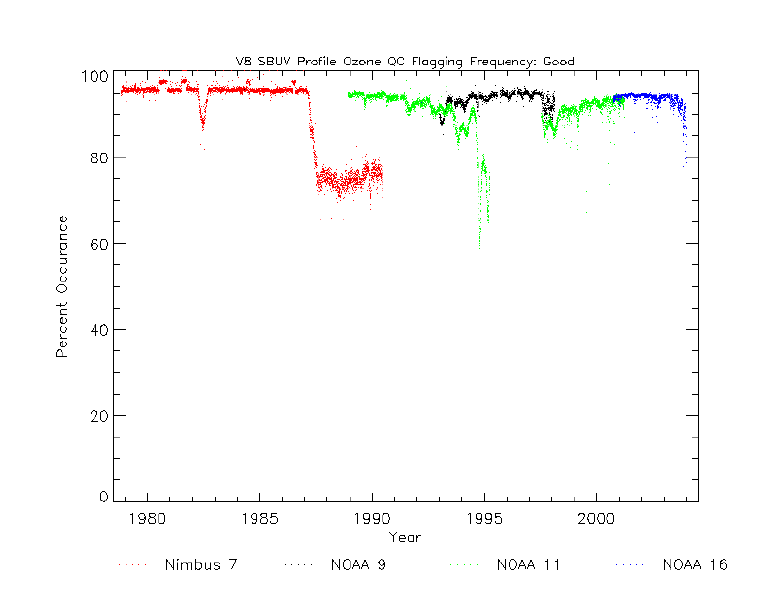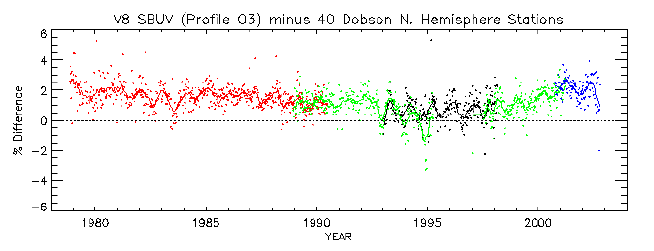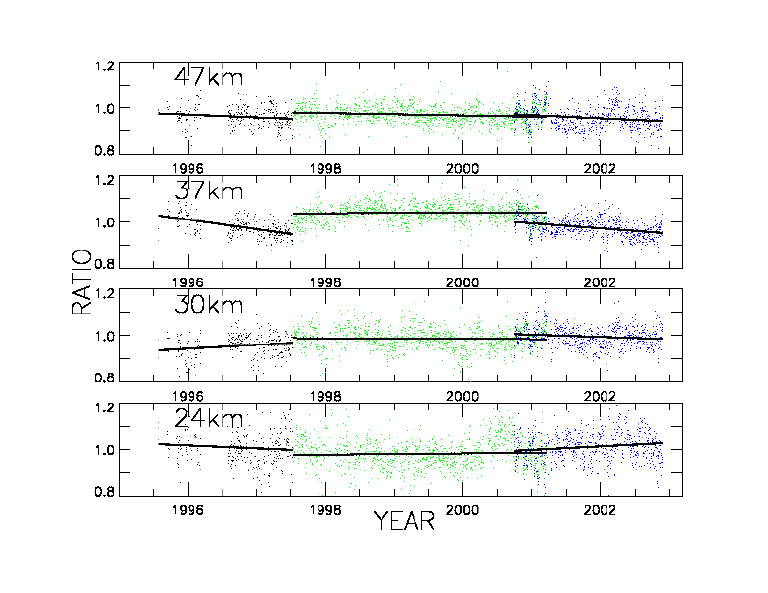Inter-comparisons of the V8 SBUV instruments (Nimbus 7, NOAA 9, 11, and 16): Time, Altitude and Latitude dependency
|
The weekly zonal mean data sets with ± 2.5 degree interval
are used to make time series plots of the ratios of retrieved to a priori layer
ozone (in Dobson Units). The figure below is the selected plot with four altitudes
(21 km, 30 km, 37 km, and 50 km) at the Equator latitudinal zone.
Instruments are distingushed with colors (red: N7, black: N9, Green: N11, and Blue: N16)
(Click on the figure below for the full size version). The
midpoint pressures of V8 SBUV 20 layers
are converted to logarithm-scale standard altitude in km using a scale height
of 7 km. The V8 a priori has an annual cycle and
annual mean that vary with altitude (approx. 5 km layers) and latitude (10
degree band), but has no inter annual or long-term variability.
Therefore, these ratio plots can demonstrate the both
V8 algorithm retrieval performance as well as possible instrument problems.
|
|
|
| Quasi-Biennial Oscillation (QBO) cycles are found in lower layers in 21 km - 24 km at the Equator. Volcanic effects in 1982 and 1991 are also seen at 30 km at the Equator. In general, most of instruments are matched up well during the overlapped time periods within ± 8 % except for early years of N9 (pre 1993 not on plots, but on DVD) due to the unsolved instrument performance issues. Mismatched alignment among instruments also has latitude and altitude-dependency, particularly in the southern hemisphere. The APPENDIX contains other latitudes and altitude versus latitude contour plots of instrument offsets in the overlaps. |
Profile Quality Checking : the Percent Occurrence of Good Profiles
| The figure below shows percentage of profiles with error code of 0 (good retrieval) and 1(solar zenith angle greater than 84 degree) per scan for each day. The significant decrease in N7 is during the non-synch period, decrease in N9 and N11 is due to grating drive problems and all N11 1995 data at high solar zenith angles. |
|
|
V8 SBUV Profile Total Ozone Comparison with Dobson Stations in the Northern Hemisphere
|
The profile total ozone is more reliable and less wavelength-dependent errors
than conventional TOMS-like total ozone product.
The matched-up V8 SBUV profile total ozone
data are averaged on a weekly basis and compared with ground-based Dobson total
ozone measurements from 40 stations in the northern hemisphere.
The smoothed data with 15 points running average are shown as solid lines for each instrument.
V8 SBUV profile total ozone is slightly
higher up to 2 % (~ 6 D.U) than Dobson total ozone, but has no significant
long-term trends.
(Click on the figure below for the full size version).
|
Seasonal Variations of Layer Ozone over Lauder New Zealand (45S, 170E)
|
The figure below is to show seasonal variations and cycles over Lauder New Zealand (45S,170E) at four altitudes.
All available matched-up samples (n=872) for the N11 time period are used to make these plots.
Thick red lines are smoothed microwave data with 7 points running average.
Blue lines are smoothed V8 SBUV data with 7 points running average.
A dynamic transport from ozone rich air in tropics builds up
the maximum ozone in late winter and early spring in lower stratosphere at 24 km.
A typical annual cycle (maximum in summer and minimum in winter) is shown in middle stratosphere at 34 km.
In upper stratosphere above 43 km, a winter (June, July, August) ozone maximum is dominant due to the reduced ozone destruction rate.
The V8 SBUV data agree well with the microwave data in terms of both offset and seasonal cycle variation.
This result is consistent with SAGE II, lidar, and sonde comparison results by Brinksma et al. [2002]
|
|
|
Time Series of Microwave to V8 SBUV Layer Ozone over Mauna Loa(20N, 156W)
|
The figure below is the time series analysis of the ratio of microwave to V8 SBUV
layer ozone over Mauna Loa (20N, 156W). Three solid lines are the linear regression fits for the time periods of N09 (Jul. 1995 - Jul. 1997), N11(Jul. 1997 - March 2001), and N16 (Oct. 2000 - Nov. 2002), respectively at four altitudes.
Mauna Loa is a good site to do intercomparison because it is not only the primary Network for the Detection of Stratospheric Change
(NDSC) station for the tropics and subtropics, but also shows a low ozone variability that minimizes the uncertainty caused by the fact that not exactly the same air volume is measured by every instrument [McPeters et al., 1999].
This plot does not show any significant trend for this short-term period (7 and 1/2 years), and also demonstrates a good agreement between SBUV instruments in the overlaps except in N09 time period coincidences at 37 km. Nevertheless, the linear regression fits
have no significant slope larger than the standard deviation (numbers not shown here) as Tsou et al. [2000] described.
|
|
|
Mean Profile Differences (%) between V8 SBUV and Ground Measurements (Microwave, Lidar and Sonde)
|
The V8 SBUV profile ozone data are validated using ground-based data (microwave, lidar, and sonde) with independent calibrations and derivation methods at various locations around globe. Microwave and lidar data are available from NDSC . Ozonesonde data are archived in World Ozone and Ultraviolet Radiation Data Center(WOUDC). The first two initials of the names of stations are used as legends on the plots as follows;
Microwave: LA(Lauder), MA(Mauna Loa), TA(Table Mt).
|
References
|
Brinksma, E. J., J. Ajtic, J. B. Bergwerff, G.E. Bodeker, I. S. Boyd, J. F. de Haan, W. Hogervorst, J. W. Hovenier, and D.P. J. Swart, Five years of observations of ozone profiles over Lauder, New Zealand, J. Geophys. Res., 107(D14), 10.1029/2001 JD000737, 2002.
Leblanc, T., and I. S. McDermid, Stratospheric ozone climatology from lidar measurements at Table Mountain (34.4N, 117.7W) and Mauna Loa (19.5N, 155.6W), J. Geophys. Res., 105, 14,613-14,623, 2000. McPeters, R. D., D. J. Hoffman, M. Clark, L. Flynn, L. Froidevaux, M. Gross, B. Johnson, G. Koenig, X. Liu, S. McDermid, T. McGee, F. Mucray, M. J. Newchurch, S. Oltmans, A. Parrish, R.Schnell, U. Singh, . J. Tsou, T. Walsh, and J. M. Zawodny, Results from the 1995 stratospheric ozone profile intercomparison at Mauna Loa, J. Geophys. Res., 104, 30,505-30,514, 1999. Tsou, J. J., B. J. Conner, A. Parrish, R. B. Pierce, I. S. Boyd, G. E. Bodecker, W. P. Chu, J. M. Russell III, D. P. J. Swart, and T. J. McGee, NDSC millimeter wave ozone observations at Lauder, New Zealand, 1992-1998: Improved methodology, validation, and variation study, J. Geophys. Res., 105, 24,263-24,281, 2000.
|
 Equator Ratio (Retrieved/Apriori) Time Series
Equator Ratio (Retrieved/Apriori) Time Series Profile Ozone QC Flagging Plot
Profile Ozone QC Flagging Plot V8 SBUV Profile - Dobson Total Ozone
V8 SBUV Profile - Dobson Total Ozone Seasonal variations of layer ozone at four altitudes
Seasonal variations of layer ozone at four altitudes Time Series Analysis of the Ratio (Microwave/V8SBUV)
Time Series Analysis of the Ratio (Microwave/V8SBUV)